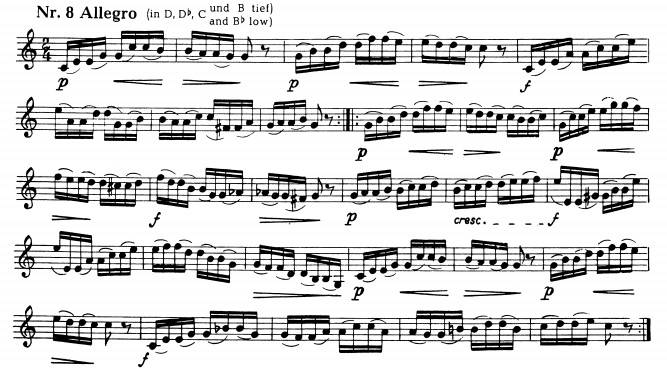Music
If you’ve read the other Kopprasch etude walkthroughs, you know that you can either find a copy of the Kopprasch etudes online at IMSLP.org or you can purchase a copy from SheetMusicPlus.com. While I think purchasing a copy is a better idea in the long run, the IMSLP edition is definitely suitable if you need something quick, or you want to look and see what the Kopprasch etudes are all about. Here is Kopprasch #8:
 Key Points
Key Points
- Although this looks like a slurring exercise, it’s actually both a test of your slurring and quick, strong articulation. Without good tonguing, the slurs (especially upwards) will be much more difficult and labored and the repeated tongued note in the middle of each 16th-note group will sound more like a tie than a rearticulation.
- This is mostly arpeggios going up, and scales going down. There are only a couple of accidentals, so this mainly focuses and scales and arpeggios in the key of C.
- These dynamics are relatively nuanced for Kopprasch. Although there are only two main dynamics, there are quite a lot of written crescendo and diminuendo.
Technical Tips
- For the repeated notes: In order to get used to the strength of articulation necessary on the repeated note, practice the 16th note patterns very slowly, and with a short or clipped second and fourth note (i.e., the notes that you are not tonguing). While not a good habit to get into (especially if you are trying to speed it up), this shorter note will enable you to hear and evaluate the quality of your articulation a little more easily. Once you are aware of the feel and sound of the good articulation, then play the 2nd and 4th 16ths at their written length.
- For the first notes: If you’re having trouble with the articulation on the first notes of each phrase, take those first two notes out of context. Play just the first and second notes (i.e. the C to E for bar 1, the G to B for bar 3, etc.), and practice playing them in time (with a metronome!) without going on. Think of saying Ta-ee to get an idea of the tongue’s impact in these patterns.
- Keep things close: With the exception of the downward E octave slurs, every slur in this piece is relatively small – a perfect 5th or less. Make sure that you practice buzzing, singing, and/or blowing the longer slur patterns (especially those going upward) to make sure that you are using only the air speed and lip tension required to play the notes and no more. It’s very easy to get a little tense in the middle register, which then makes the upper register either extremely tense or impossible.
- The dynamics help the slurs: Following the dynamics will make most of the slur patterns a little easier, so don’t neglect them! Also, in my edition, there is a calando in measure 20, which provides a nice moment for a breath before the recapitulation-like phrase in bar 21. This is an example of some of the nicer editorial marks in the print versions of these etudes!

